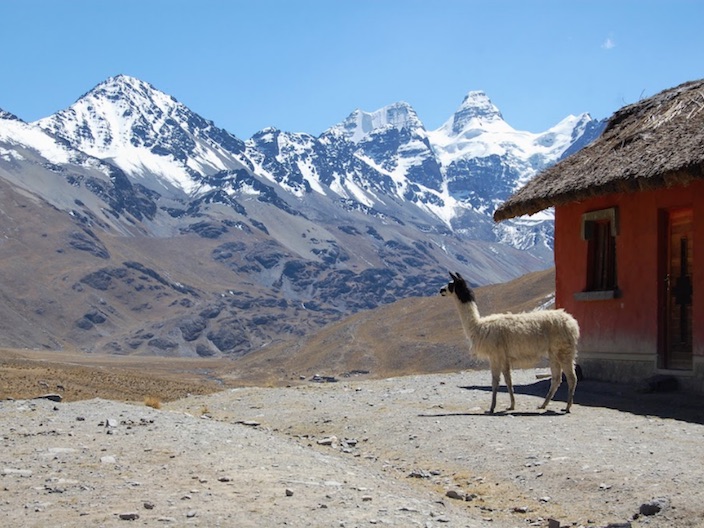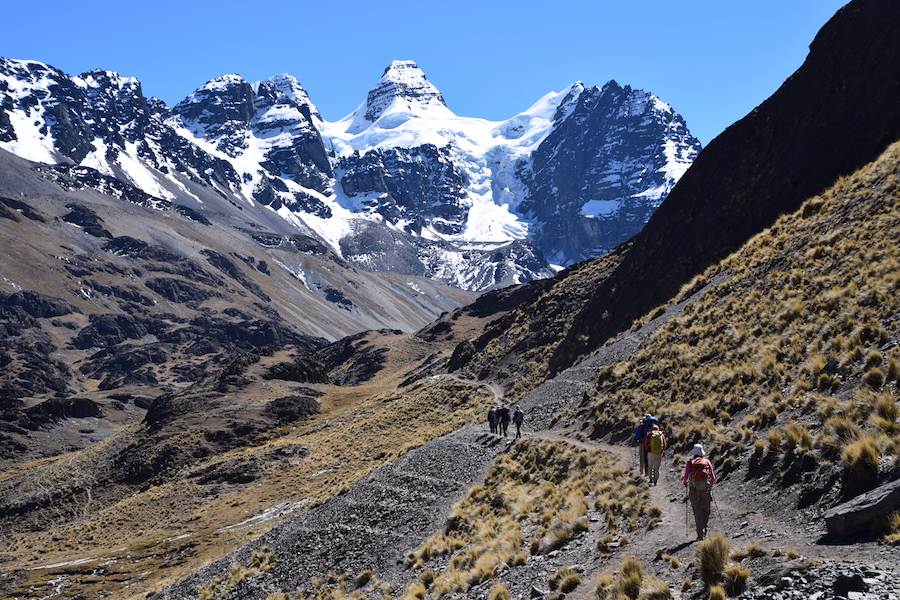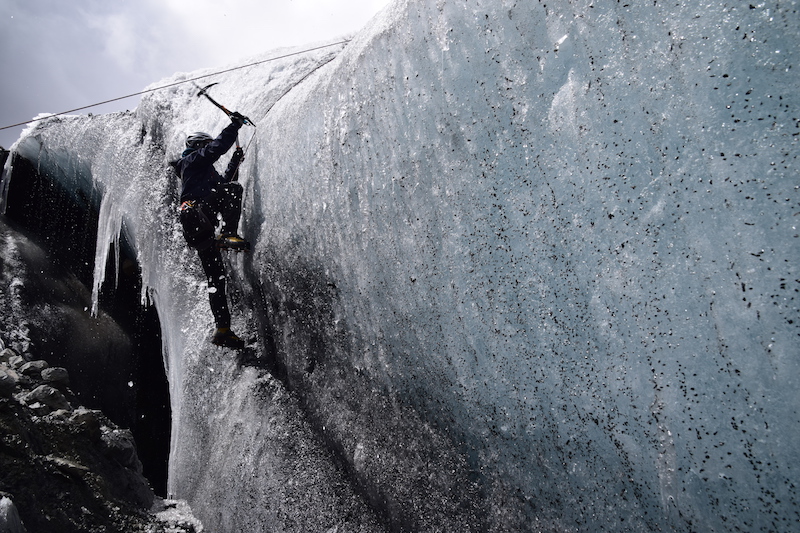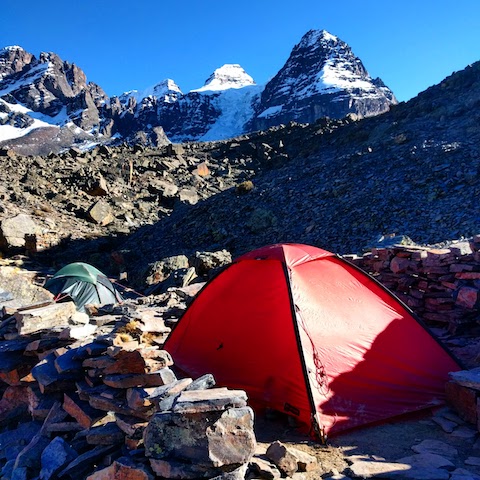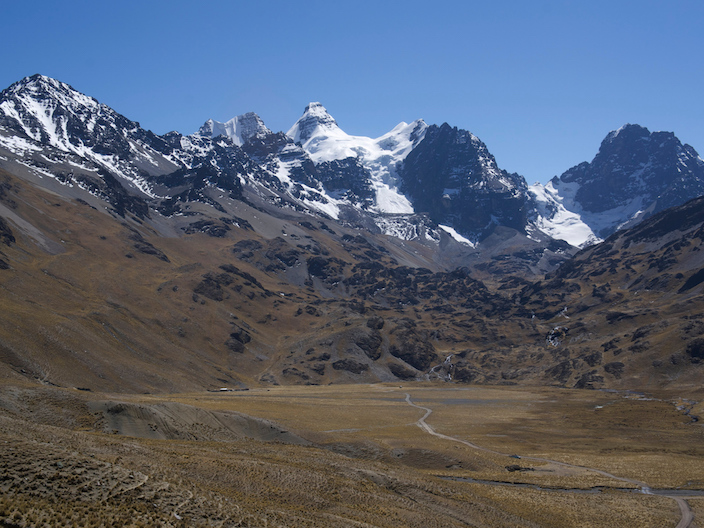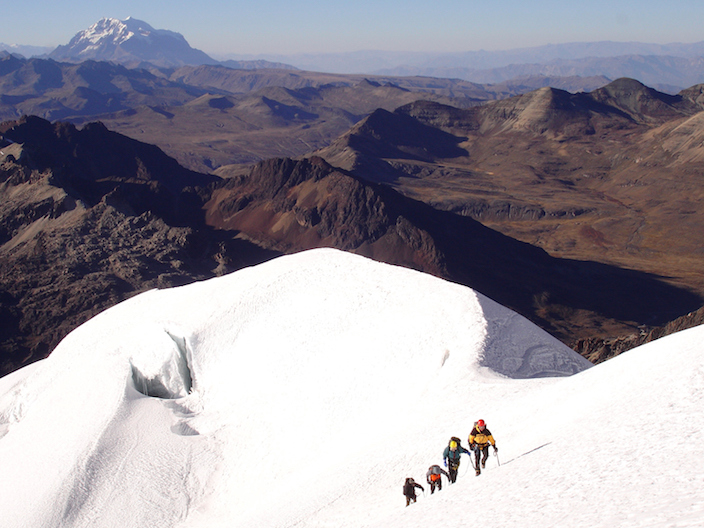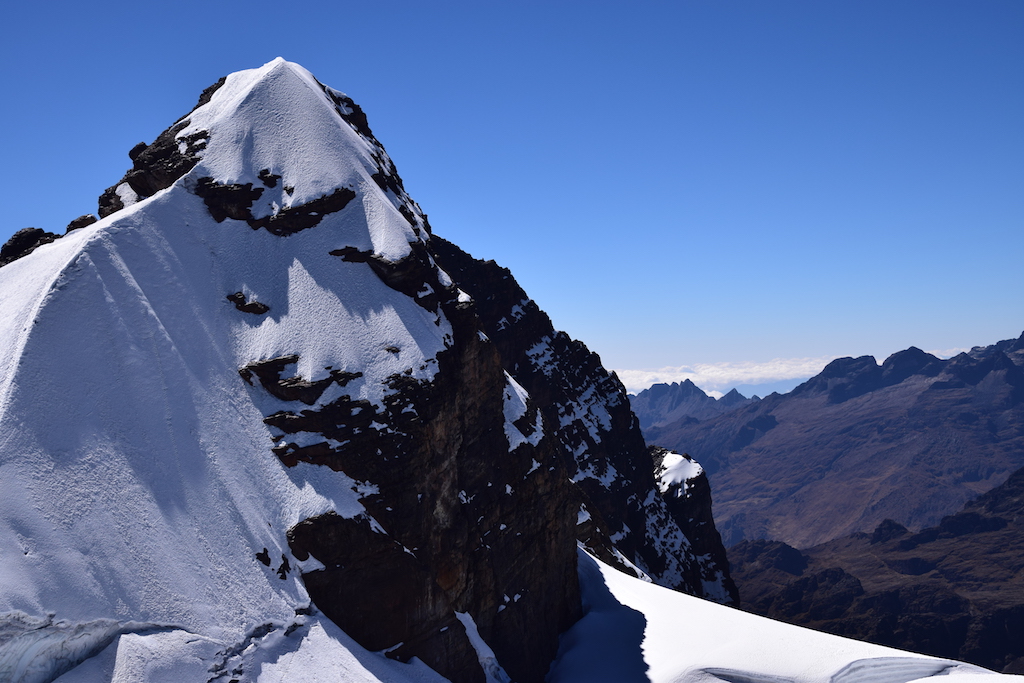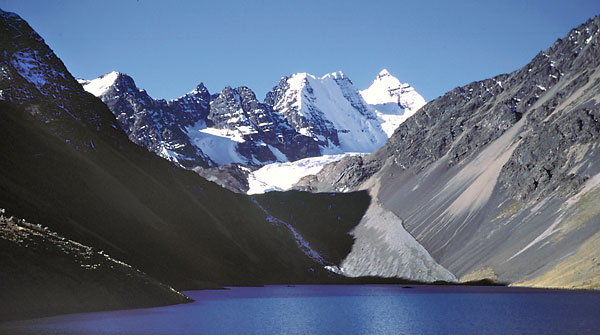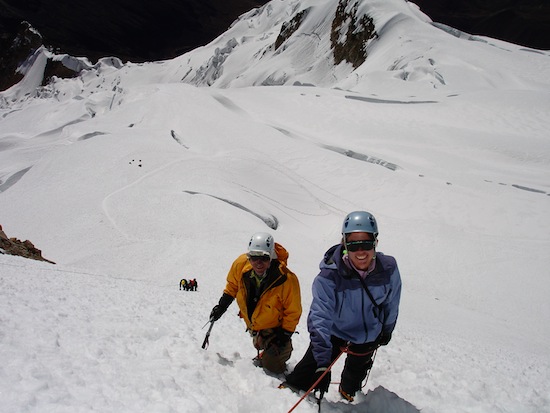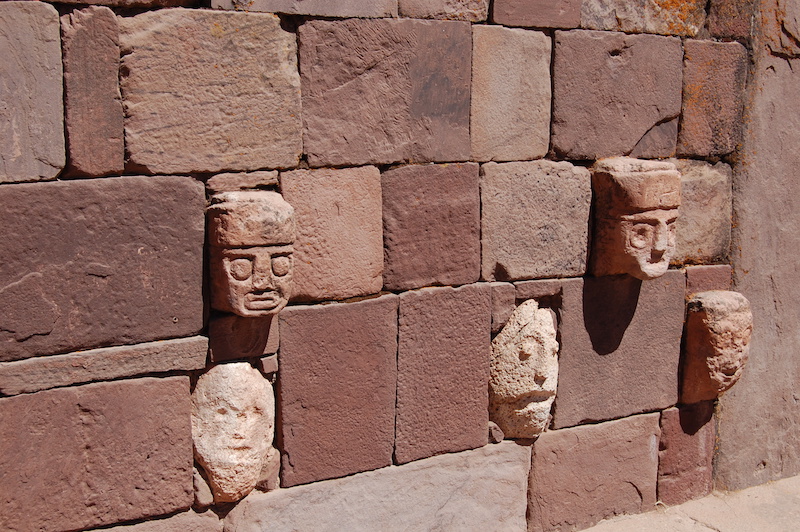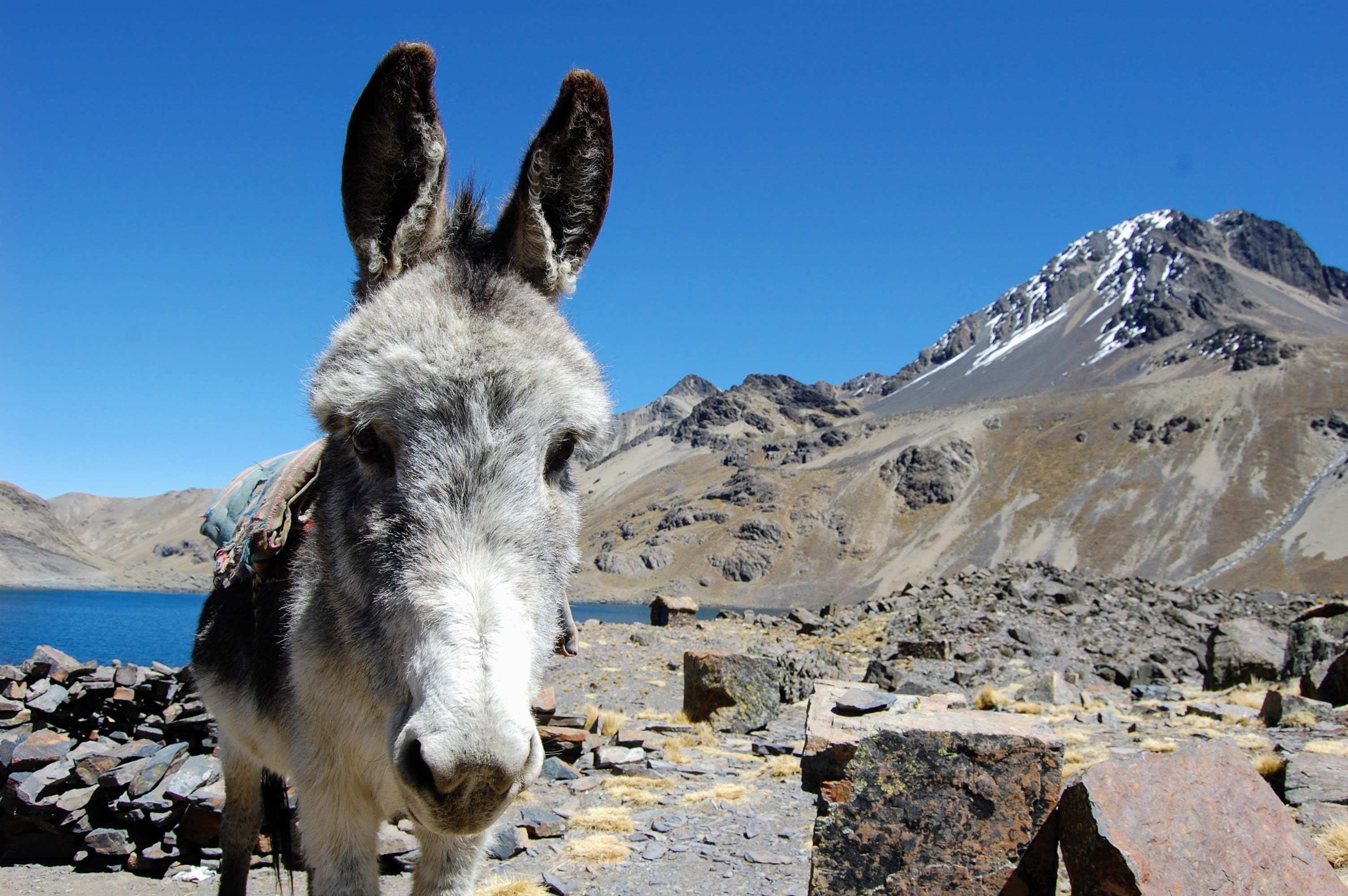Bolivia - Huayna Potosi Skills Expedition
Overview
This trip is currently unavailable.
Contact the AAI Office for further details. Alternatively, we offer our Cotopaxi Skills Expedition and Chimborazo Ascent in Ecuador or our Ice Field Expedition or Gorra Blanca Ascent in Patagonia.
Summary of Bolivia Programs
Bolivia - Huayna Potosi Skills Expedition is a 10-day climbing program that includes skills instruction and review that is presented at both introductory and more advanced levels. The introductory level includes a day learning fundamental alpine mountaineering skills and is designed for those with little or no glacier climbing experience. The more advanced level includes a day to review basic and intermediate techniques and helps experienced climbers further advance their route finding, hazard evaluation, and technical climbing skills.
Note: Both the introductory and advanced sections occur at the same time from the same base camp. The groups will only split up during the day to accommodate different skill levels and climbing goals.
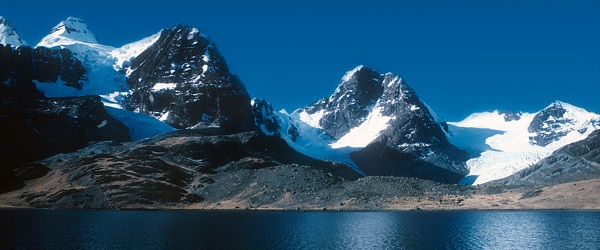
The Condoriri Lake District is one of the Andes' most beautiful sub-ranges. Miles Newby
Both programs encompass a series of high altitude climbs (17,000' to 20,000') and both need to be preceded by a period of acclimatization. You can acclimatize on your own for five to seven days in Bolivia or join us for the Bolivia Trek - La Paz and Cordillera Real. Folks will commonly precede this trek with three additional days at moderate altitude in our Cuzco and Machu Picchu program exploring the extensive and beautiful remains of the Inca Empire in eastern Peru. Some climbers enjoy having family members and friends join for just these portions of the program, before the climbing begins during the skills expedition.
Most climbers participating in Bolivia - Huayna Potosi Skills Expedition stay an additional five days for our Bolivia - Illimani Expedition, a climb of the highest peak in the Cordillera Real. Though it stands at 21,201-foot, climbers enjoy an extremely high rate of success because of their thorough acclimatization in the earlier parts of the program.
Zero Carbon Footprint Expedition
This expedition has a zero carbon footprint. Through AAI's Climate Initiative, the Institute pays to offset all carbon emissions incurred by the guides and clients on each trip, including emissions from flight, local transportation, electricity in hotels, and fuel burned to cook in the mountains. To learn more about how this works and AAI’s dedication to environmental protection, click here.
Bolivia - Huayna Potosi Skills Expedition
Itinerary
The Cordillera Real of Bolivia is one of the world's major ranges and offers some of the finest and most varied alpine climbing, but it is probably the least known and least climbed range among comparable mountain groups. This is due to the country's remoteness and its lack of any traditional tourism. As a result, for those who are used to climbing and backpacking in wilderness areas, for whom the experience of a minimally impacted and uncrowded area is important, and who find great appeal in exploring a remote and exotic land, the Cordillera Real offers an unparalleled opportunity.
The first day of the Huayna Potosi Skills Expedition is spent traveling by boat on Lake Titicaca and driving across the altiplano to a trailhead in the central part of the Cordillera Real. Those only participating in the Bolivia Trek – La Paz and Cordillera can also join us for this day's activities.
Covering a substantial part of Bolivia's altiplano, Lake Titicaca is the world's highest navigable waterway. From its waters we enjoy memorable views of the scores of seventeen to twenty-thousand-foot peaks that make up the Cordillera Real. The range has great vertical relief, characterized by steep faces of ice that rise up in contrast to the broad and undulating altiplano below. While on Lake Titicaca we visit a small island where Incan terraces from the 15th century are still actively used for farming by local villagers. Traditional life along the shores of Lake Titicaca includes a rich culture of farming, spinning, weaving, and reed boat construction; much as during the rule of the Incas.
In the afternoon we drive east from the lake to the foot of the central Cordillera Real and then to a trailhead. Those participating in the Huayana Potosi Skills Expedition meet their support staff and pack animals before establishing camp for the night. Those ending their trip will travel back to La Paz, passing high altiplano lakes and driving through small Aymara settlements. They spend the night in La Paz before departure for home the next day.
The itineraries described below for the introductory and more advanced options are the ones usually followed. Depending on conditions, some programs may climb in the more remote central part of the range and finish with an ascent of 19,902 ft Chachacomani.
Introductory Course (Part A): Alpine Mountaineering Instruction and Ascents
GOALS
To help climbing enthusiasts with little climbing experience become capable of gaining safe access to wilderness alpine areas; to help them become proficient in basic and intermediate alpine mountaineering skills; to convey to them an appreciation of the serious requirements placed upon the mountaineer and the entire team when climbing at altitude; and to help them understand and protect the fragile alpine environment. We work to instill in participants both concepts and skills that will allow them to climb in high altitude alpine areas safely and confidently. Upon completion of this program, each participant should be qualified as a technically competent rope team member capable of safely ascending high altitude alpine routes of intermediate difficulty.
PREREQUISITES
Previous backpacking and cold weather experience – Required
Previous mountaineering experience is helpful
Participants must acclimatize for seven days before beginning this program segment, ideally spending most of that time between 10,000 and 12,000 feet, either by joining Bolivia - La Paz and Cordillera Real of this program or by conducting their own comparable trip.
ITINERARY
Having reached the trailhead as described above, we meet our arriero and his pack animals before setting out the next morning. With the animals carrying the bulk of our gear, we will make an easy-paced ascent to our base camp at 15,000 feet. The trek takes us through some beautiful valley landscapes, and our camp provides excellent views of the many surrounding mountains. The position of our camp will allow us to make a series of single-day ascents in the surrounding area.
During the first days of the program we tailor our schedule of instruction and practice climbing to suit the needs of the participants acclimatizing at different rates. Instruction will be provided in climbing technique on a glacial practice area near our camp.
As team members gradually acclimatize to the 15,000 to 16,000-foot altitudes we will cover additional skills in the process of making summit climbs. After trekking to the Condoriri Lake District we will make two ascents on 17,000 and 18,000-foot peaks. This area includes two of the most beautiful mountains on the continent, Cerro Condoriri and Pequeno Alpamayo.
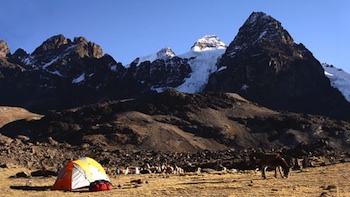
Condoriri base camp. Andrew Wexler
Using pack animals our approaches and camp moves are made easier. One camp is near a lake below the magnificently sculptured white tower of Condoriri. After practicing additional climbing and rescue techniques we will make our first major climb, most likely of the beautiful Pyramide Blanca.
After a day of rest or more practice climbing, we tackle our primary goal in this group, Pequeo Alpamayo, a hidden peak with a very impressive pyramidal summit. The route climbs a broad glacier up to a col and traverses along a ridge below the summit pyramid before ascending directly to the summit. This route is very photogenic, and offers excellent climbing, making use of all the skills taught during the preceding days.
Moving south, we pass a series of colorful altiplano lakes to the Zongo Pass, at the very foot of Huayna Potosi (variously calculated from 19,996 to 20,011 feet). From the pass, we will take a full day to establish a high camp at 18,000 feet.
We will set off from our high camp the following morning before sunrise. The climb is a very aesthetic route which includes glacier travel and intermittent sections of steeper terrain. The climbing will be challenging but well within the skill set developed during the preceding days of the expedition. Huayna Potosi's summit is a well-defined point at the end of a beautifully sculptured ridge. The last few steps before the summit will provide an exhilarating finish to a great climb. Although this summit is at high altitude, the acclimatization undergone during the Bolivia Trek in La Paz and Cordillera Real and the climbs preceding this major ascent will give each team member a very good chance for success.
CURRICULUM
- Selection & use of personal equipment
- Anchors for fixed & running belays
- Selection & use of ropes, knots, & harnesses
- An introduction to high altitude physiology
- Design & selection of technical equipment
- Response to high altitude illness
- Principles of glacier travel
- Nutrition during extended trips at altitude
- Belaying techniques on snow & ice
- Introduction to natural hazards evaluation
- French & German cramponing techniques
- Crevasse rescue procedures
- Principal ice axe positions
- Rappelling
- Concept & application of the self-belay
- Route finding & evaluation
Intermediate to Advanced Course (Part B): Ice Climbing Technique and Ascents
GOALS
We review intermediate skills depending on the group members' skill level. Additionally, we will cover a hybrid climbing technique which combines aspects of American, German, and French approaches to snow and ice with the goals of perfecting technique and developing consistency within the climbing team. The amount of time spent practicing climbing techniques varies according to the needs and interests of the group members, but we at least briefly cover use of second ice tools; adjustment in technique in response to different Andean snow and ice types; protective systems; establishment and operation of belays on steep ground; belay change-over sequences; free climbing technique on steep ice; and the integration of specific skills with the general goals of efficient and safe climbing.
PREREQUISITES
This program is designed for those with significant, previous alpine mountaineering experience climbing at or above an intermediate skill level. Those with less experience should join Part A.
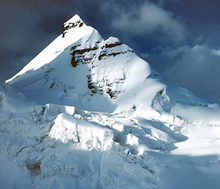
Cerro Condoriri, one of the most beautiful climbs in the Andes.
Mark Houston
ITINERARY
This program follows the same basic itinerary as Part A (described above). Ascents of different routes and/or peaks will be made from the same base camps. Depending on conditions and skill level, there may be opportunity to attempt new or more obscure routes.
The team does a great deal of climbing during this expedition, normally ascending two or three 17,000 to 18,000-foot summits. Summits are in the Condoriri Lake District and either the North Ridge or steep East Face of Huayna Potosi. Particularly strong teams, may do an ascent of Cerro Condoriri (18,530 ft / 5648 m) a sustained and exposed climb on one of the most beautiful mountains in the Andes.
Those interested in continuing their climbing expedition can join us for the Bolivia - Illimani Expedition.
Bolivia - Huayna Potosi Skills Expedition
Testimonials
"My guides were simply outstanding. They provided an informed sense of the setting, both in La Paz and on the Altiplano. They were supportive of each climber's individual potential, they were excellent teachers of the critical skills needed on the glacier, and their quiet leadership was a spur to everyone to accomplish his/her own objectives."
Richard Jessor, Boulder, CO
"Both guides met my expectations and needs extremely well. They were thorough with all necessary instruction to give me complete confidence on the climbs."
Bob Jackson, Chicago, IL
"They were knowledgeable about climbing techniques, areas visited, the culture, and the specific climbs. They skillfully negotiated the details and logistics, with time left over to create a fun, friendly, and relaxed environment. I would definitely climb with my guides on future trips."
Natasha Civalli, Longmont, CO
